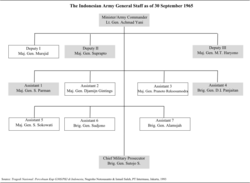Cornell Paper
[2] Led by Lieutenant Colonel Untung Syamsuri of the Tjakrabirawa, the Presidential Guard,[3] the movement arrested members of the Council of Generals and assumed control of media and communication outlets.
[7] Kahin "found [himself] in disagreement with some of the views presented in this paper";[8] however, he called the work a "tour de force" for providing an "impressive analysis" of the events despite the limited amount of access to information.
[8] In the opening paragraph of the synopsis of the study's results, Anderson and McVey outlined their tentative conclusions: The weight of the evidence so far assembled and the (admittedly always fragile) logic of probabilities indicate that the coup of October 1, 1965, was neither the work of the PKI [Communist Party of Indonesia] nor of Sukarno himself.
Anderson and McVey observed that the more traditional officers believed "soldiering itself is less a matter of techniques and skills, than the development of moral and spiritual faculties through a kind of modernized asceticism".
[10] Officers of the Diponegoro Division had a number of sympathizers throughout several military branches inside and outside the capital city, including Lieutenant Colonel Untung Syamsuri of the presidential guard.
[12] The officers understood that "the one occasion in the year when Diponegoro troops could legitimately be in Djakarta was the annual parade and demonstration put on by paratroop, cavalry, armor and other units for Armed Forces Day October 5".
[14] Anderson and McVey theorized that the night of Thursday, September 30, was chosen for the operation because it is a time of the week when, "in universal Javanese belief, magical forces are abroad, and spiritual strength and support most readily obtained".
[15] They further discovered evidence that at least two "prominent leaders" other than Sukarno were evacuated to Halim Perdanakusuma: Air Force Commander Omar Dani and PKI Chairman Dipa Nusantara Aidit.
Anderson and McVey suggested that Aidit's presence would "prove to the President that the PKI was inextricably compromised in the affair, and therefore that if he wished to preserve his 'leftward course', [...] he had no alternative but to come out" against the Council of Generals.
[16] Anderson and McVey emphasized that in the announcement made on the morning of October 1, "Untung repeatedly stressed that the September 30th Movement was purely and simply an internal Army affair".
Refusing to follow Untung for a final stand at the Diponegoro Division headquarters in Central Java, Sukarno retreated to Bogor Palace where he was placed in the custody of the Army.
Anderson and McVey believed this to be the case because of a three-week absence of violence that ended on October 21, when Communist youth elements clashed with the Army Para-Commando Regiment (Indonesian: Resimen Para Komando Angkatan Darat, abbreviated as RPKAD) in Boyolali Regency.
However, Anderson and McVey expressed their doubts that the PKI would consider using violence as a course of action as it "would have involved pitting itself against a vastly superior military force and might have thrown the President into alliance with the army".
[31] Anderson and McVey argued that "the Chinese have not been risk-takers, not have they been inclined to sacrifice promising relations with a non-Communist power in the interest of promoting a local revolution with dubious prospects".
[33] The second alternative to Anderson's and McVey's interpretation was that, instead of masterminding the operation, "[the PKI] played a role at one remove—by persuading the President, directly or indirectly, to attempt the removal en masse of his and their military enemies".
The primary planning of the operation would then be conducted by Sukarno, motivated to remove Army General Staff members who opposed his idea of a "Nasakom" (Indonesian: Nasionalis, Agama, dan Komunis; English: Nationalist, Religious, and Communist) state.
The first was an independent move by Untung and his movement to seize control and remove members of the Army General Staff for their "Western orientation", "Menteng mentality", and "obstruction of Sukarno's endeavors" without the desire for popular support.
[37] If Untung and his men did not want to involve the civilian movement to prevent its coup attempt from being thwarted by the Army, Anderson and McVey then believed Sukarno must have been a key figure.
This decision was made after taking into consideration the safety of colleagues and former students conducting work in Indonesia for fear that they "could possibly be held accountable for the views expressed in the paper".
[5] The existence of the paper became public after The Washington Post's Joseph Kraft published an article on March 5, 1966, reporting the contents of "a study of recent Indonesian events by a group of scholars at Cornell University".
[42] Scholars and journalists who requested copies of the study from Cornell were turned down, but several received a four-page document titled Hypothesis on the Origin of the Coup Analysis and mistook it for the actual paper.
[43] Alternative versions of the paper's thesis were also published by Cornell graduate Daniel Lev in the February 1966 issue of the Asian Survey and by Lucien Rey in the British journal New Left Review the following month.
In his 1969 book The Communist Collapse in Indonesia, author Arnold Brackman identified Lucien Rey as "a cover name for someone who, on the basis of the article's content, must have had access to at least one version of the 'Cornell Paper'.
In observing the unstable political climate of Indonesia since the events of 1965, Kahin wrote in the preface to the publication, "It will probably be some time yet before a reasonably comprehensive and sound analysis can be written.
[48] When Kahin visited Indonesia in June 1967, he met with the intelligence officer responsible for coordinating the interrogation of political prisoners and formulating an official government account of the October 1, 1965, incident.




